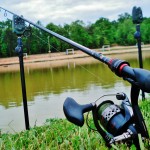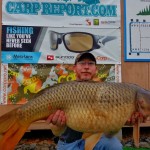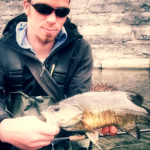In the South, even the smallest change is often perceived as an unwelcomed threat to one’s way of life. Southern anglers often display the same pugnacious fortitude in traditional fishing ideals. For the multi-species enthusiast working to eliminate the “trash fish” mentality of old fashioned anglers, the South is a tough battle ground. Some fish, despite undeniable sporting quality, have simply been buried by scornful myth, particularly our non-native carp species.
Scorned for indiscriminately vacuuming up game fish eggs, smelling up the water, and spreading out of control, carp face a major uphill battle among anglers in the South. There are communities of anglers tucked away, however, who are promoting this worthy species by offering to pay anglers to catch them! These “pay lakes” are drawing massive interest across the South and slowly but surely exposing carp as a formidable species to pursue by rod and line. “Paylaking” involves competition at all levels, and rewards angler’s with a competitive edge with a variety of prizes including cash.
On a typical day of “paylaking”, anglers pay in on a drawing. A system may involve placing numbers into a bucket to determine who gets to pick their favorite station or peg on the lake first. After anglers set up on the location they draw, competition begins and all anglers battle it out for the money! There are typically several different ways to win. There may be winners in 10 minute intervals, or every hour depending on the specials being run on that particular day. A winner may be determined by whoever catches the biggest fish for that time frame, or the most.
Blending money, gambling, and the excitement of a big fish, paylaking is extremely addicting. For example, 50 anglers could pay 20 dollars into a pot offering an overall winner the opportunity to take home $1000 dollars just to catch big fish! Events drawing a big number of competitors can result in huge payouts.
There are many different ways that anglers can cash in on trophy fish and big numbers at pay lakes. Many lakes stay open 6 days a week and often times there are prizes for the angler who caught the biggest fish or the most during the course of the week. Prizes can be cash, trophies, or fishing gear/bait.
Having been carp fishing for a number of years recreationally, I recently tried my hand fishing at a well established pay lake in my home state of South Carolina. Pineyside Lake and Grill is located in Inman South Carolina and that means big fish in good numbers scarcely more than a half hour away from my home in Greenville. I was enamored by the countless photos on the Pineyside Lake and Grill Facebook page of fisherman displaying massive fish and getting money in the process! I made a visit to the lake myself confident that I could surely tie into dozens of fish in such a small body of water. It became immediately apparent that anglers cannot simply go in to a pay lake with a can of corn and expect to catch fish. With weekly events pressuring the fish all year round, carp swimming in these lakes have seen it all. It became quickly apparent that some of my elementary methods of capturing carp with bread, corn, creep pellets, or basic dough recipes were simply not going to cut it.
Pineyside Lake is among the oldest pay lakes in SC. The lake dates back to the 1950’s where it was originally an irrigation pond for a peach orchard. 10 years later it was transformed into a carp pay lake. In 2006 the lake was acquired by USCarpPro co-owner and pro-staffer Keith Cisney. Since then, the lake has made a radical transformation with efforts from Gary Ruble and friends. The 56 peg lake now operates year round and during the Spring and Summer months there are tournaments nearly every day of the week. The community surrounding the lake is tight nit and competitive. Anglers from the surrounding areas find themselves immediately drawn to the competitive atmosphere with a family feel to it. The lake also hosts events which draw interest from anglers all over the country, and why would it not? There is a real chance of pulling in fish exceeding 40lbs from this lake. The body of water is less than 4 acres large, but with proper management it sustains an estimated 40,000 lb of fat carp!
The average fish caught in a typical day at Pineyside is close to 20 pounds. The lake offers more than just common carp, however. Blue catfish and Smallmouth Buffalo also inhabit the lake and have been caught in trophy size. The idea of calling any fish average at that size is hard to wrap your mind around but this propensity to deliver such size in numbers is planting a seed in this region of the South which is, perhaps, opening the minds of local anglers. Competitive carp angling is also driving fisherman to take a scientific approach to bait selection. Paylakes like Pineyside are ground zero for the growing market for new and improved baits, scents, and rigging technique. Because paylakes can be so pressured, fishermen have to try new things to keep the fish happy, and stay ahead of the competition.
Being completely novice to ‘paylaking’ culture, I failed miserably on my first attempt at catching even a single fish at Pineyside Lake. This was not because the lake couldn’t deliver, I could see huge shadowy figures looming about all over the entire like. There were carp breaching out of the water every few seconds and a group of anglers on the other side were pulling fish left and right. On my next trip to Pineyside Lake I stepped into the shop, where Sharon Ruble operates an outstanding grill that keeps anglers well filled and fueled up for long hours of battling big fish. Gary Ruble, Keith Cisney, and the whole Pineyside Crew are extremely accommodating and genuinely want to put their customers on the fish. I found myself quickly fixed up with a basic ‘pack bait’ set up complete with a variety of CarpPro scents and a mixture of scents concocted by Pineyside patrons.
The crew set my wife Erin and I up on a wide stretch of the pond working almost 10 rods on bite alarms. Gary Ruble laughed to us and said “I hope yall brought your running shoes!”. As darkness took over the pond it became clear as to why we would need a good pair of sneakers. As the peak hours hit the bite alarms were buzzing every few seconds from all directions. We got our fill on fish but the tips and techniques acquired by the staff and lake regulars were priceless.
Anglers of all ages and walks of life flock to the shores of pay lakes like Pineyside and it was extremely gratifying to see the young anglers who will undoubtedly lead the charge for carp as a formidable game species in the future. As discouraged as I have found myself when attempting to promote carp fishing, the element of competition in pay lakes is pushing many anglers to re-think outdated notions about carp.
















